#Xinhai Revolution
Text
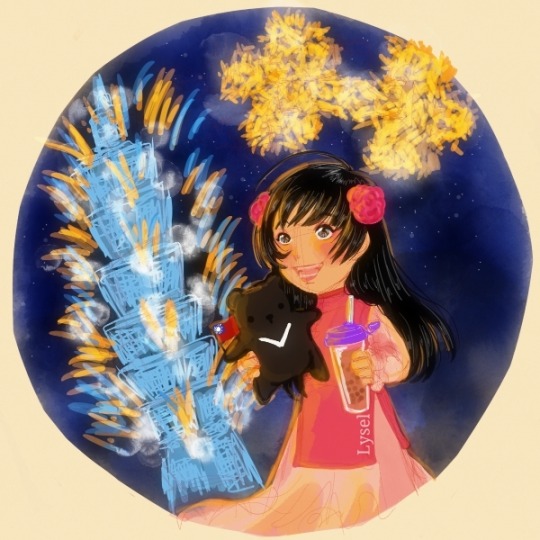
🎉🎉HAPPY DOUBLE TEN DAY 雙十節🎉🎉
#hetalia#aph taiwan#taiwan#Taiwan national day#xinhai revolution#fanart#vintage anime#lyselkatzcreations#misc#bubble tea#taipei 101#fireworks
9 notes
·
View notes
Text

A rare image of the three flags of the Republic of China together. At center, the first national flag (see Image:Flag of the Republic of China 1912-1928.svg), at left the army flag (see Image:Chinese-Army-Wuhan-Flag-1911-1928 dots19.svg), and at right the Sun Yat Sen flag (now the flag of Taiwan) (see Image:Flag of the Republic of China.svg).
Underneath the picture is the slogan "Long live the republic!" (共和萬歲, in traditional right-to-left single-character column order).
Dated prior to the 1930 or 1929
Found on page 1 of Made in China by Reed Darmon, Chronicle Books LLC, 2004, ISBN: 0-8118-4202-9, www.chroniclebooks.com
Source: Wikimedia Commons
#graphic#art#woodblock#Wuchang Uprising#Republic of China#military#Sun Yat Sen#Xinhai Revolution#1920s#1910s#Tongmenghui#Wikimedia Commons#Hubei Military Government#20th century#Taiwan#nationalism#republicanism#China#Chinese#history#flags
8 notes
·
View notes
Photo

“Throne Will Accede to Rebels,” Winnipeg Tribune. December 27, 1911. Page 1.
----
Chinese Imperial Court and Premier Give Up Fight - Regret Powers Refused Loans For War Purposes
----
Peking, Dec. 27. - Representative members of the imperial court, according to an an authoritative source, have signaled to Premier Yuan Shi Kai their willingness to agree to an abdication. The court, the same authority states, realizes that there is no hope for it in the detention of three or four detached sections of the country and semi-royal provinces, and hopes to obtain better terms by agreeing to the proposed referendum on the form of government.
The premier is certain that he could win several battles with a modern army at his disposal, but as he is unable to obtain any loans he would be unable to reconquer the lost provinces.
Premier to Resign
Yuan Shi Kai in all probability will resign his office after making the best terms possible for the throne. He considers Tang Shao Yi, a deserted, and suggests that the latter might become president of the republic, an office he himself would not accept.
Yuan Shi Kai also regrets that foreign nations have withheld their financial support with which he could have reconquered the country.
#beijing#qing empire#qing china#emperor of china#xinhai revolution#辛亥革命#chinese revolution#qing dynasty#xuantong emperor#溥儀#manchu dynasty#anti-qing politics#end of the qing#yuan shikai#history of china#chinese history
2 notes
·
View notes
Text
What’s a specific time period you wish there was more historical fiction about
#me personally#Chinese Revolution of 1911#Xinhai Revolution#the drama#the intrigue#esp since so many of the prominent revolutionaries were#students who had just come back from studying abroad#the Qing was assassinating people left and right#the end of a dynasty and the horror that followed#their vision for China was so clear and beautiful but then it all fell apart almost instantly#feel so bad for sun yat sen honestly#sorry went off on a tangent but it would just be a very very interesting time period to write about
0 notes
Photo

Map of china in 1911, the year of Xinhai revolution which ended the Manchu rule
170 notes
·
View notes
Text
just pondering how old nations deal with the tumult of change; and i personally think that yao might’ve been the last to cut his hair short, after kiku and yong-soo. imo kiku did it first with the onset of the meiji era in 1867, followed by yong-soo during the gwangmu reforms launched by emperor gojong in the 1880-90s; the monarch is in western dress and short hair—and so is the nation. for yao, it’s not that he’s oblivious to how things are falling apart and the urgent need for reform. but he is the oldest of the three of them; he has kept long hair for thousands of years. it’s not that he hasn’t ever experienced defeat and changes at the hands of another nation—but as controversial as the manchu-style braid imposed by the qing dynasty rulers on the whole male population of china was, i think there was still that underlying sense of continuity with long hair for him; wearing his hair long became the one constant in his identity amidst all the drastic changes he’s weathered through the millennia.
and so in the wake of the opium wars, i think it fits if yao’s the one now left behind, watching his sort-of protégés turn away from his worldview symbolically. from being seen as the civilisation to emulate, by both tributaries and even enemies, to being defeated by the very same gunpowder technology invented during one of his golden ages. and kiku and yong-soo see what’s happened; the summer palace is burned to the ground, and yao is no longer the one at the centre of “all under heaven”. they followed yao’s clothing styles, philosophies, religion and kept their hair long like he did—but no longer, after this. he’s staring at the backs of their heads this time, and the only path seems to be to join them. because when it comes down to it, imo, yao won’t die on the sword of tradition for its own sake—he’s survived by being willing to change shape and form throughout history. it takes some time for him to work up to it this time, but he does, in the end— short hair and western dress it is, by the time of the xinhai revolution in 1911: ‘i have been called many names throughout many lifetimes. the empire is dead, long live the republic.’
#hetalia#hws china#hws japan#hws korea#hetalia headcanons#i feel like Yao had short hair through quite long periods in the 20th century#and it's more recently that he's grown it out long again for multiple reasons#whereas Kiku and Yong-soo never went back to long hair
136 notes
·
View notes
Note
VOR of Sun Zhongshan?
Hm, probably overrated though still decent VOR. Sun Zhongshan - or Sun Yat-Sen as he is commonly known in the west - was in fact the leader of failed rebellions, multiple of them, in the lead-up of the 1911 Xinhai rebellion - he was almost deposed in 1907 as the leader of his revolutionary party, the Tongmenghui. He was uninvolved in the Xinhai revolution himself as well, which itself was a very decentralized revolution. I think its pretty apparent that the death of the Qing Dynasty was a structural affair, with so many individual dissidents piling up that the monarchy couldn't stand anymore. If Sun magically dies it makes no big difference.
What he was talented at was getting overseas Chinese to channel funding into domestic revolutionary movements, that job he does with few peers. This did not matter too much for 1911, but for the founding of the rival KMT government in Canton as the new Republic of China collapsed, it mattered much more - that foreign funding & expertise would give it the assets it needed to be a locus for modernizing factions in China. Additionally, here Sun Zhongshan was ahead of the curve - he was advocating for a new government to be built as early as 1914, and being rebuffed by most of his liberal compatriots who were still trying to make the doomed Republican government work. And timing matters a lot here - the KMT needed to move quickly to take advantage of the power vacuum of collapse to build strength. When the collapse happens he is out front, ready to roll, and people (including the Soviets!) flock to him for it. Then he dies, whoops.
So for much of his history he is low VOR, but these things are a work of a lifetime - when it mattered, for a brief window he was the only guy in the room to see what needed to happen and was able to make it work. B-
14 notes
·
View notes
Text
me on a date with a man for the first time in years: "this man date must be of heaven"
to which he responds: with a bout of screaming in agony as he is transformed into a 2d jpeg of The Dynastic Cycle as occurred in China on-and-off until the Xinhai Revolution in 1911

16 notes
·
View notes
Note
Don't you think it is too short of time for Wu in your fic to abdicate? He does it in a year? Is that really realistic?
Well, are badgermoles realistic? Or weapons that shoot purple spirit energy? Or people that can bend elements? I mean. It's a fantasy world, not a biography of a real person, so.
That being said!
I based a fair amount of Wu and his family history on the actual history of the end of the Qing Dynasty in China. Puyi, China's last emperor, was forced to abdicate in 1912 when he was only 6. (He'd been the emperor, with first his father and then the dowager Empress as his regent, since he was 2.) This was due to the Xinhai Revolution which took place in 1911; at that time a general in the Chinese army, Yuan Shikai, was appointed Prime Minister of China. Once Puyi had abdicated, a provisional president was put into place in 1912. (He lasted for two months and then Yuan took over from him.)
So the entire revolution, abdication of the emperor, and establishment of the Republic of China with a president happened in 5 months.
Now granted, the revolution was some time in coming! Many people were very unhappy, and there had been fighting on and off for a decade. But the actual salient dates are:
The Xinhai Revolution: 10 October 1911 – 12 February 1912
Yuan Shikai made Prime Minister: 11 November 1911
The Abdication of Emperor Puyi: 12 February 1912
Yuan sworn in as president of the new Republic of China: 10 March 1912
So yeah. It took exactly 5 months for it to happen in real life actual China. It takes Wu, in my fic, about 2 years total to do it. So to answer you: Yes. I do happen to think it's realistic. Doesn't mean it would be Bryke's take on it, or the take of anybody else's headcanons, but I didn't just pull that timeframe willy-nilly out of my ass. My ass is autistic, and it likes to research first.
It's stated in my fic that Wu and his advisors take advantage of the chaos still happening due to Kuvira to break down the Earth Kingdom into several smaller independent kingdoms/nations that are allowed to come up with their own democratic processes, while the entire enormous city of Ba Sing Se essentially becomes its own nation. Gun, Wu's great-aunt's Grand Secretariat retires when Wu finally finishes abdicating. I also establish that another Grand Secretariat - this one democratically elected - is put into place in Ba Sing Se along with a constitution and an elected parliament, but Wu bops the fuck off to Republic City and the United Republic because he has some concerns that if he actually stayed in Ba Sing Se there would be a lot of nonsense with people trying to either assassinate him (which does actually happen to him in my fic) or put him back into absolute monarchial power and reinstate the Earth Kingdom (again, based on the actual history of China in the first half of the 20th century, and also something that a faction of people, the Royalists, are doing in the background of a lot of my fic).
I think Bryke mentioned at some point that they thought of the Earth Kingdom becoming a constitutional monarchy much like modern-day Bhutan is (so essentially there is a king/emperor but there is a democratic constitution in place along with elected officials - see also Japan, the European monarchies that are still left, etc.). In that case Wu would be King Hou-Ting, but there would be a constitution put into place and democratic voting for a parliament and prime minister, etc. etc. etc. He'd stay in Ba Sing Se. Bhutan's constitutional monarchy took nearly 7 years to put into place - there was no revolution involved and they really did it the right way there, all of the populace was involved, there were lawyers, etc. (In fact, per the new Bhutanese constitution, the reigning monarch has to retire in their 60's just like everybody else.) So sure, if Bryke (or anyone else writing fic) wanted to take Bhutan as an example then taking 5-10 years to do it would work out really well and would, I think, be very compelling watching/and or reading.
However, I am about 99.99% sure that Bryke does NOT ship Mako and Wu, so for them having Wu fuck off back to the Earth Kingdom and spending 5-10 years putting into place reforms and a new constitution and then marrying some nice princess to continue the Hou-Ting lineage while Mako mopes around Republic City with his old teenage haircut and his scarred up arm and maybe getting lucky with a retconned Fire Nation princess works out well.
Since I DO happen to ship Mako and Wu, then I did it the way I did. So. Ya know. Still though. China. From Absolute Monarchy to Republic with President in less than half a year. True story.
4 notes
·
View notes
Text
Happy Birthday 🎂 🥳 🎉 🎈 🎁 🎊 To A Very Most Elegant Asian Beauty & Highly Regarded Amazing Actress Of Remarkable & Critically Acclaimed Roles In Both National of Her country & International Roles in the US & etc.
She is A Chinese Born Actress & Singer
She was born in Wuchang, Heilongjiang, China. She initially had no intention of becoming an actress and enrolled specifically in a high school for prospective school teachers. However, upon graduation, she discovered her interest in acting and was eventually persuaded by a friend to join the Shanghai Theatre Academy in 1993.
She rose to fame after starring in Zhang Yuan's Seventeen Years (1999), which won her the Best Actress Award in the 1999 Singapore Film Festival. In 2001, She starred in the television series Young Justice Bao, which propelled her to become one of the most famous actresses in China.
She was subsequently labelled as an "action actress" as she starred in a number of wuxia television series, such as Taiji Prodigy and Eight Heroes.
She achieved breakthrough with her performance in Feng Xiaogang's A World Without Thieves. She then starred in Dayyan Eng's romantic comedy film Waiting Alone, for which she received her first Best Actress nomination at the Golden Rooster Awards.
In 2009, She won Best Actress at the 46th Golden Horse Film Awards for her performance in The Message, about Japanese invaders in China who try to ferret out a spy among their Chinese collaborators.
She then starred in Tsui Hark's 2010 action-mystery film Detective Dee and the Mystery of the Phantom Flame. She played Shangguan Jing'er, a fictional character based on Shangguan Wan'er, a prestigious politician during the Tang Dynasty. She established her studio in the same year, co-starring and co-producing the film 1911 with Jackie Chan, which was released in September 2011 to celebrate the 100th anniversary of the Xinhai Revolution.
Her first-time in an English-language film is Wayne Wang's Snow Flower and the Secret Fan, adapted from Lisa See's 2005 novel of the same title. The film premiered at the 2011 Cannes Film Festival. She started to gain recognition in Hollywood after starring in Resident Evil: Retribution, playing Ada Wong. The same year, she was cast in action fantasy film 400 Boys, directed by British director Alastair Paton.
In 2013, She attended the 4th Annual US-China Film Summit and received the East-West Talent Award. Hollywood magazine Variety also named her Asian Star of the Year. The following year, She was featured in Transformers: Age of Extinction, the fourth installment of the film franchise. This helped solidify her success overseas.
In 2015, she was cast in 3D science fiction thriller Nest (also known as Guardians of the Tomb), a Chinese-Australian co-production that was finally released in January 2018. The same year, it was announced that She would play China's first female superhero in upcoming film Realm, written by Stan Lee.
In 2018, She starred with Jason Statham in The Meg, an American-Chinese shark film based on Steve Alten's 1997 novel Meg: A Novel of Deep Terror.
Her Best Well Know Role Is In the 2008 Martial Arts Film
Starring Jackie Chan & Jet Li
In
THE FORBIDDEN KINGDOM
As She Played The Iconic & Infamous China's Villainous Character in Chinese Martial Arts Films.
THE WHITE HAIRED WITCH 🧙♀️
She Is A Very Well Know Established Actress In China 🇨🇳 1 of the Many Great Actresses today
& A Charity Ambassador Of The Shanghai World 🌎 Expo & A Goodwill Ambassador Of UNEP
Even though she may not look it. She has aged Very Gracefully & Amazingly over the many years. As A Bad@$$ Action Actress In Wushia
Please Give A Very Well Round of Applause & A Very Happy Birthday Wishes To
The 1
& The Only
MS. LI BINGBING / BING BING LI
HAPPY 50TH BIRTHDAY 🎂 🥳 🎉 🎈 🎁 🎊 TO YOU MS. BINGBING & Here's To Many More 💖
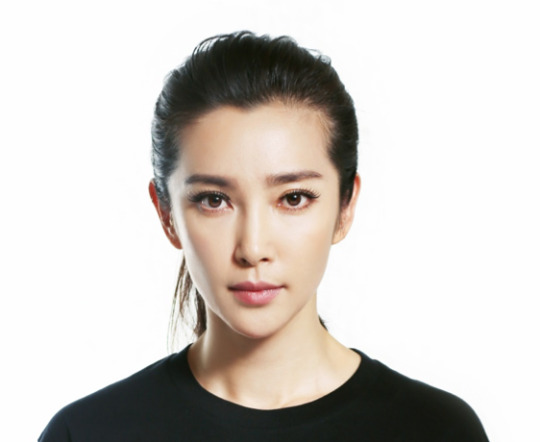
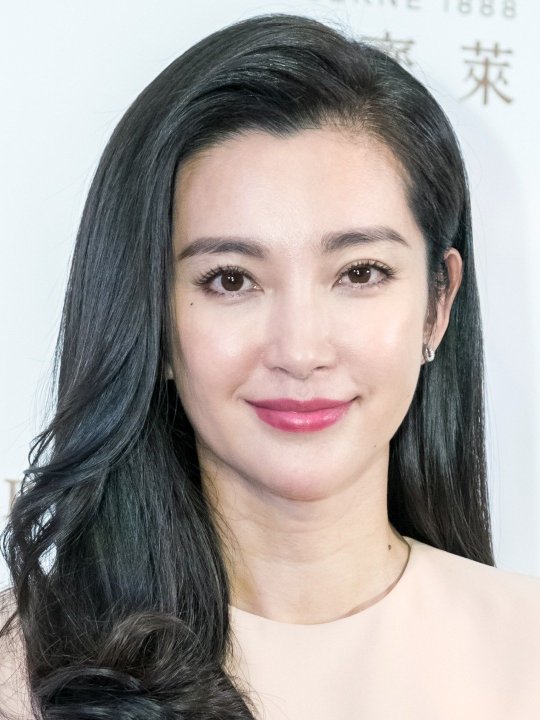



3 notes
·
View notes
Photo

Fritz and Hedwig Weiss, German consul and his wife, take a photograph during a walk on the path along the city wall, Chongqing. c. 1912. Source.
#chongqing#重庆#city walls#black and white photograph#qing china#qing empire#end of the qing#republican china#xinhai revolution#german consul#imperial germany#black and white photography
1 note
·
View note
Text

China, 10 coppers revalued as 5 Fen (cents), and restricted to Szechuan (Sichuan) Province. c1933-35 or later.
The note depicts Linggu Pagoda, completed in 1933 and dedicated to the soldiers who died during the Xinhai Revolution (1911-1912) which overthrew the Qing Dynasty. 30,000 soldiers are buried nearby.
The nationalist government that issued this note was so notoriously corrupt that by 1949, it was itself overthrown after years of civil war.
4 notes
·
View notes
Text
sofi posts good quarterly reports, stock tanks anyway. general zhang xun while still in the beiyang army during the surpressed xinhai revolution said that a scorpion who wears a lamb's wool has a harder carapace than the scorpion who hides under a rock. without him, nanjing would have fallen. one of the many ways in which wisdom transcends battlefields
0 notes
Photo

If China broke up after the fall of the Qing Dynasty
by u/Aofen
In our timeline, after the fall of the Qing Dynasty in the 1911 Xinhai Revolution, China descended into a period of civil war and political instability, with regional warlords controlling different sections of the country throughout the 1920s.
In this timeline, the same strong regionalism of the army and society that enabled the power of warlords instead causes the complete dissolution of China, with independent governments laying claim to various provinces. The history of the now independent countries of China varies. Guanwaiguo (a Japanese puppet state as Manchukuo until the end of WWII), Mongolia, Uyghuristan, an Huangguo come under the domination of the Soviet Union, with Mongolia and Uyghuristan even being incorporated into the USSR itself. Tibet maintains its independence under its theocratic government, eventually reforming to become more democratic in the 1990s. The states of southern China follow a path similar to our Taiwan or South Korea, being US allies that democratize in the later part of the 20th century.
87 notes
·
View notes
Text
In the eyes of Western art, what does Eastern jewelry look like?
In the early to mid-20th century, with the awakening of feminist consciousness, vanity cases became a fashionable symbol for elite women in high society. During this period, the Art Deco artistic decoration style was prevailing, and Cartier perfectly aligned with this trend. The Art Deco style emphasized symmetry, geometric shapes, luxurious materials, exotic elements, and unique designs—principles that resonated with Cartier's creative philosophy. After the Xinhai Revolution, a large number of precious artifacts from the Qing Dynasty flowed into countries like England and France, sparking a rapid increase in Europe's interest in Eastern art, culture, and design elements. This provided Cartier with an opportunity to blend Eastern styles, leading to the creation of some highly artistic Chinese-inspired vanity cases of significant cultural value.

An 18-karat gold, lacquer, mother-of-pearl, enamel, and gemstone-adorned Chinese-style vanity case by Cartier, Paris, circa 1927.
In a Sotheby's auction, this rectangular Chinese-style vanity case is equipped with a black lacquer base, adorned with tinted mother-of-pearl, creating a vibrant display of iridescence. The lid depicts a serendipitous encounter in a Chinese-style figurative garden, drawing inspiration from traditional Chinese brush painting techniques, utilizing pointillist perspective, and emphasizing detailed line work. The combination of 18-karat gold with black lacquer and mother-of-pearl allows the piece to showcase both luxury and dynamism through material juxtaposition. Decorated with geometric patterns, the piece seamlessly blends Chinese brush painting, mixed materials, and Art Deco style, expressing both artistic sensitivity and innovation while reflecting Cartier's contemporary interest in Chinese art and culture.
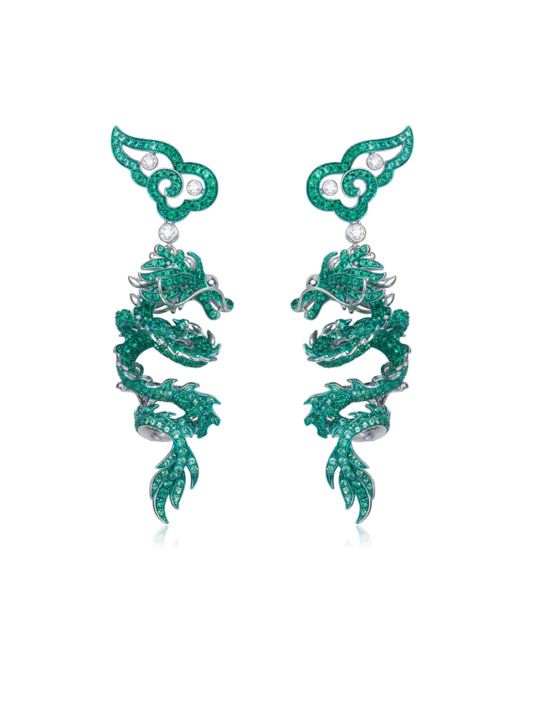
ChuCui Palace "Hidden Dragon" Earrings
Not only Cartier, but about 30 years later, ChuCui Palace, a high-end jewelry brand originating from a jewelry workshop in Rome, Italy, also focused on Chinese meticulous and freehand painting. In comparison to Cartier's use of meticulous style in the flat application of vanity cases, ChuCui Palace integrates meticulous style into three-dimensional high jewelry. Their piece "Hidden Dragon" earrings take inspiration from the traditional Eastern cultural totem - the dragon. Embracing the meticulous and detailed qualities advocated in meticulous painting, the earrings depict the Eastern azure dragon spiraling and ascending. Although static, the tension and elegance in the dynamic present are palpable. At the dragon's head, the piece refines the traditional Eastern ornamentation "cloud pattern," creating a contrast between simplicity and complexity, abstraction and concreteness. Using white diamonds as intervals, the dragon's body is as intricate as lines, with auspicious clouds intertwined as surfaces, highlighting the rhythmic sense of the piece. The work is dominated by blue gemstones and white diamonds, symbolizing the purity of traditional Chinese ink and color. Although employing Western techniques, the artistic expression is rooted in the logic of traditional Chinese painting, representing a three-dimensional reshaping of meticulous Chinese painting and a reinterpretation and creation of jewelry after in-depth research on meticulous Chinese painting.
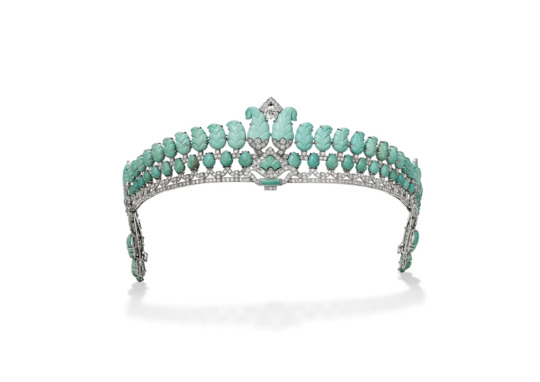
A high-end headdress in Persian style designed by Cartier in 1936.
In 1910, two exhibitions on Islamic art captured the attention of Louis Cartier. The exquisite and intricate miniature paintings, the vibrant clash of colors distinct from the Belle Époque's whites, and various geometric patterns left a profound impression on him. As a result, elements inspired by Islamic culture, such as patterns, motifs, and even architectural details, found their way into Cartier's high-end jewelry. In 1936, the brand drew inspiration from the bindings of ancient Iranian books from the pre-Islamic era. They created an exquisite headdress featuring a "Boteh" pattern crafted from turquoise, framed with diamonds in geometric patterns. This masterpiece not only embodies the distinct elements of Middle Eastern tradition and fashion but also exudes refined modernity. It allows people to see the details of cultural origins while conforming to contemporary trends. The geometric style of Islamic culture seamlessly integrates with the geometric elements of Art Deco, while the combination with turquoise brings a totemic exoticism, presenting cultural inclusivity, Middle Eastern culture's subtlety, and an aristocratic temperament.
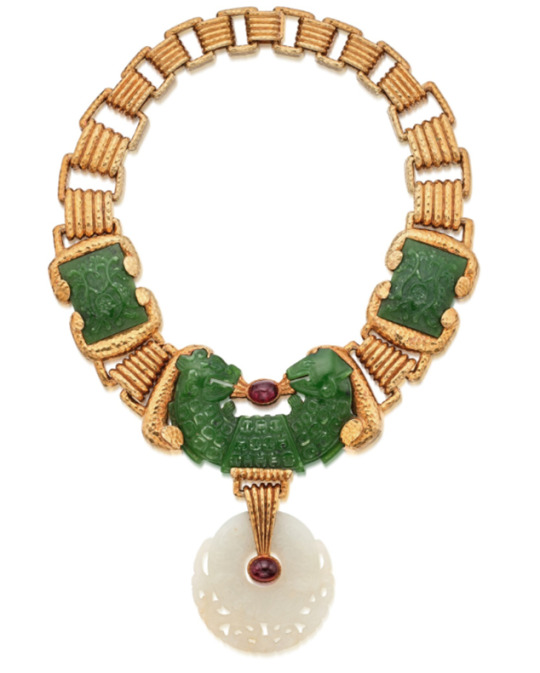
David Webb's Gold, Jade, and Ruby Necklace
In 1972, the American jewelry brand David Webb expressed its fascination with Chinese and Pre-Columbian cultures by creating a gold, jade, and ruby necklace. The combination of jade, gold, and rubies in the design creates a powerful sense of cultural fusion. The necklace features hammered gold patterns and a wide, bold size, exuding a primitive and wild charm. The intricate detailing of the Pre-Columbian motifs on the green jade plate engages in a dialogue with the Chinese-inspired openwork patterns on the light-colored white jade pendant. The interplay of various cultures, materials, and patterns showcases a strong sense of retro aesthetics and eclectic style.
In the collision of Eastern and Western cultures, jewelry design has emerged as exquisite works of art that transcend time and space. Brands such as Cartier, ChuCui Palace, and David Webb have absorbed elements from traditional Eastern cultures, delving into Islamic art and Persian patterns. Through diverse material combinations and innovative pattern inheritances, they have created a series of creative and uniquely styled jewelry pieces. These works not only continue traditions, allowing people to see the details of cultural origins, but also radiate new brilliance in a modern context, showcasing cultural inclusivity and continuous innovation in jewelry design. Each piece of jewelry tells a story, connecting the cultural heritage of East and West, serving as the intersection of art and fashion. These exquisite jewelry creations, like precious symbols of time, narrate profound emotions and historical legacies between different cultures, offering an artistic feast that spans civilizations.
0 notes
Text
0 notes